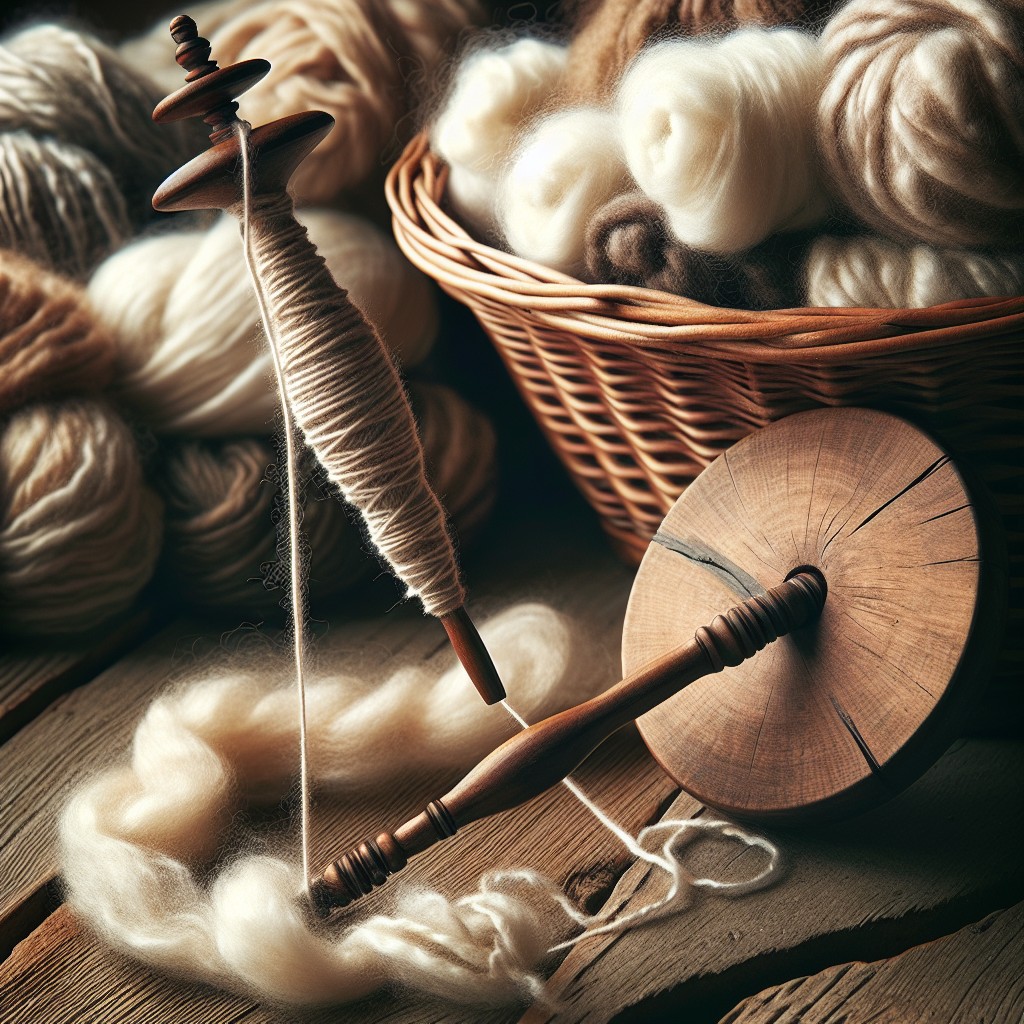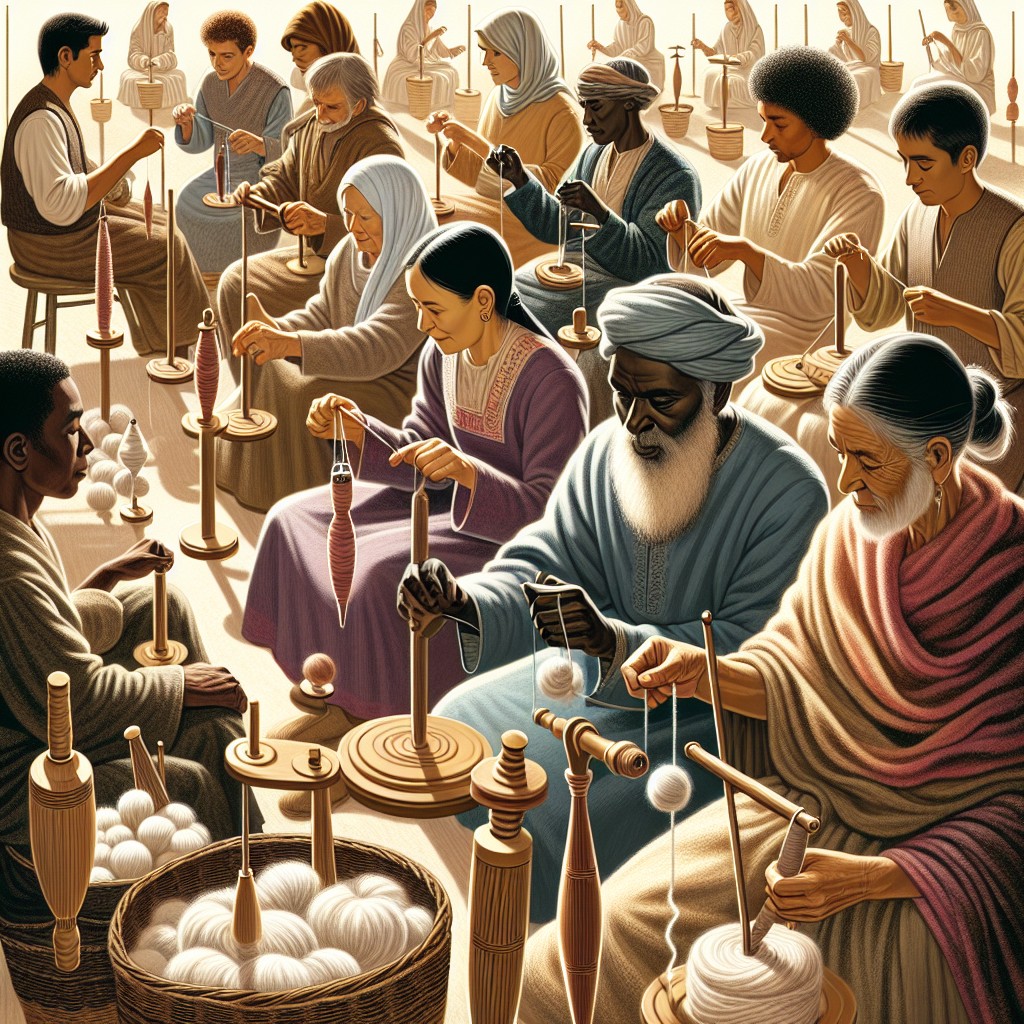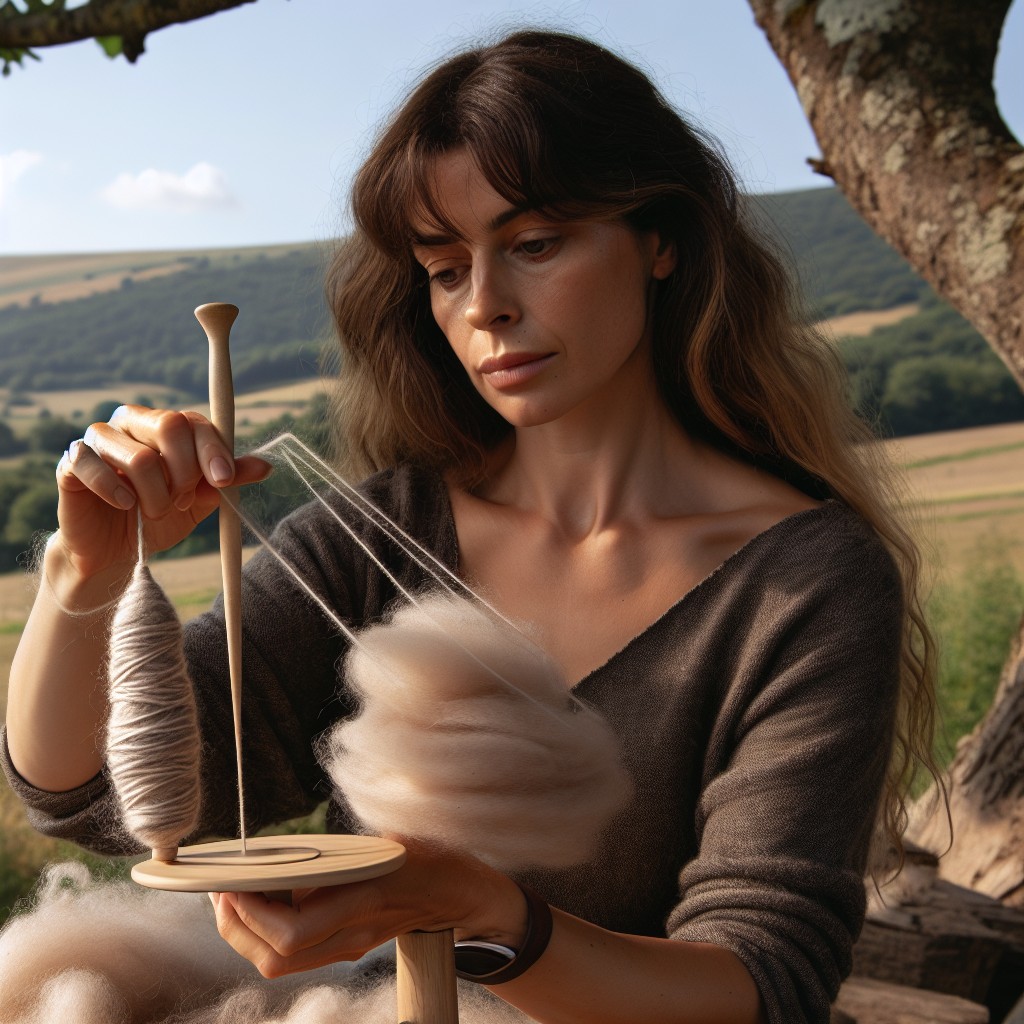In this tutorial, you’ll discover the simplicity of using a drop spindle because it opens up the world of hand spinning fiber into yarn at any place and at your own pace.
Key takeaways:
- The key to using a drop spindle effectively lies in the balance of twist and tension.
- Selecting the right drop spindle is crucial for an enjoyable spinning experience.
- Understanding the difference between spindle types enhances your spin technique.
- Starting with the right fiber facilitates the learning process for beginners.
- Before spinning, fibers must be prepared by carding or combing to align them.
What Is a Drop Spindle?

A drop spindle serves as a simple, portable tool for transforming fiber into yarn. Its design, consisting of a weight (whorl) attached to a shaft, harnesses the power of gravity to add twist to fibers.
Dating back to ancient civilizations, its enduring presence speaks to its effectiveness and the tactile pleasure it provides. Spindles come in various weights and sizes, tailored to different types of fiber and preferred yarn thickness.
They are equally adored by beginners for their accessibility and by seasoned spinners for the control and intimacy they offer in the spinning process. With practice, a drop spindle can produce yarns ranging from delicate lace weights to robust, chunky textures.
Choosing a Drop Spindle

Selecting the right drop spindle is crucial for an enjoyable spinning experience. Consider its weight; lighter spindles are ideal for fine yarns, while heavier ones better suit thick, chunky yarns.
The balance of the spindle also affects the smoothness of spin. Test the spin before purchasing, if possible.
Spindle whorls come in top, bottom, and center configurations, which influence the yarn’s tension and spin. A top or high whorl spindle is easy to learn on and good for beginners.
Additionally, look at the spindle’s hook or notch, as it guides the yarn and keeps it from slipping.
Lastly, find a spindle that fits comfortably in your hand, ensuring long spinning sessions without strain.
Types of Drop Spindles

Understanding the difference between spindle types enhances your spin technique and yarn creation.
Top-whorl spindles feature the whorl or weight at the top, allowing for high-speed spinning and fine threads. Their hooks at the upper end guide the yarn and maintain tension.
Bottom-whorl spindles have the whorl at the bottom, resulting in a slower spin ideal for thicker, heavier yarns. The yarn spirals up the shaft, usually secured by a notch.
Turkish spindles, identified by their crossbars, produce a ball of yarn directly on the spindle and are easily disassembled for yarn removal.
Supported spindles rest on a surface while spinning, suited for delicate fibers like cashmere, and result in very fine yarn.
Analyzing these variations helps you select the optimal tool for your desired yarn weight and fiber type.
Best Fiber for Beginners

Starting with the right fiber facilitates the learning process. Wool is a forgiving material for novices, as its natural crimp improves grip and its generous staple length allows for easier spinning. The most recommended types are Corriedale and Merino, known for their balance between softness and manageability.
Avoid short-staple fibers, like cotton, or slippery ones, such as silk, until you’ve gained more experience. They require advanced techniques and precision, which can prove challenging without a solid foundation in basic spinning.
Also, consider pre-drafted roving or top. These preparations are aligned and require less drafting, letting you focus on maintaining the spindle’s motion and mastering twist insertion.
For your first spin, an undyed fiber might be preferable – it can reduce distractions, allowing you to see and correct any irregularities in your spinning. Color can be introduced once you’re comfortable with the basics.
Preparing Yarn for Spinning
Before spinning, fibers must be carded or combed to align them, which makes drafting easier during the spinning process. This can be done by hand or with a drum carder for larger quantities. Carding creates a fluffier preparation called a ‘rolag,’ suitable for woolen spinning, which results in a lofty, warm yarn. Combing, on the other hand, produces a sleeker fiber preparation known as ‘top’ or ‘sliver,’ ideal for worsted spinning, yielding a smoother, denser yarn.
Select fibers with a longer staple length, about 4-6 inches, as they are more forgiving for beginners. Ensure that the fibers are free of tangles and debris. If using a raw fleece, it will need to be washed to remove lanolin, dirt, and grease. This process, known as scouring, helps fibers slip easily past each other during spinning.
For dyed fibers, make certain colors are fast, preventing color bleed during spinning. Join fibers at the ends by slightly twisting and fanning them out. Overlap another bunch of fibers over these, and gently tug and twist to connect. This creates a ‘continuous’ supply for a consistent weight and thickness in the spun yarn.
How Does a Drop Spindle Work?
To spin yarn with a drop spindle, you essentially twist fibers to create a stable thread. The weight of the spindle maintains momentum, twisting the fiber as it hangs.
Here’s what happens in the process:
- Twisting for Strength: The spindle’s rotation twists the fibers, which interlock to form a continuous, strong thread.
- Gravity at Work: The drop spindle uses gravity to help elongate the fiber as it’s being twisted, which makes it into yarn.
- Controlled Threading: You manage the tension and thickness of the yarn with your fingers, a technique known as drafting.
- Twist Accumulation: As you spin, the twist travels up the yarn. Once enough twist has accumulated, you let the spindle drop, which adds more twist automatically due to its weight and spin.
- Building the Yarn: When enough twist is in the fibers to hold them together, you wind the yarn onto the spindle, creating a ball called a cop.
- Consistency Counts: Keeping a steady rhythm in the spin and draft ensures a consistent yarn thickness and strength.
Remember, the key to using a drop spindle effectively lies in the balance of twist and tension. This balance dictates the final quality of the hand-spun yarn.
Add a Twist
The twist is the magic that transforms fluff into yarn. It’s essential for strength and cohesion.
To add a twist:
- 1. Spin the spindle with a flick of your fingers to start it rotating. The direction (clockwise or counterclockwise) will determine the yarn’s twist — Z-twist or S-twist, respectively.
- 2. Allow the spindle to hang freely. Its weight will maintain the spin and pull on the fibers slightly, which is helpful as you draft.
- 3. Control the twist. Keep it from traveling too quickly into the fiber supply by pinching the fibers above where you want the twist to be.
- 4. Release the pinch slowly to let the twist combine the fibers into yarn.
- 5. Periodically stop and wind the created yarn onto the spindle shaft, storing it below the whorl to keep your working area free.
Draft the Fiber
Once you’ve added the initial twist and your spindle is spinning consistently, you can begin to draft the fiber. This process involves gently pulling and extending the fibers to determine the thickness of your yarn.
- Hold the fiber supply in one hand and tease out a small amount with your fingers, allowing the twist to travel up and capture these fibers.
- Manage the tension by feeling the fiber as it’s drawn out – too tight, and it won’t draft easily; too loose, and the yarn will be uneven.
- Aim for a consistent thickness by monitoring the yarn being formed, adjusting your drafting speed to match the spindle’s twist.
- Practice the “park and draft” method if the spindle’s momentum is overwhelming – stop the spindle (park it) and focus on drafting without the added complexity of spinning.
- Advance periodically by winding your newly created yarn onto the spindle’s shaft, ensuring it’s secure and the weight continues to balance for smooth spinning.
Remember, drafting is a skill refined over time. The motion should feel relaxed and controlled, enabling a rhythmic and serene spinning experience.
Working With Different Materials
Different materials will affect the spinning experience and the final yarn product. Natural fibers such as wool, cotton, and silk each have unique properties:
- Wool is elastic and forgiving, ideal for beginners. It has scales which help fibers cling together, making it easier to spin.
- Cotton lacks elasticity and can be more challenging to spin. It tends to create a smoother, cooler yarn, suitable for warmer climates.
- Silk offers a luxurious feel, producing a lustrous and strong yarn. It is a bit slippery, requiring a more delicate touch.
Synthetic fibers and blends can also be spun using a drop spindle. They may provide consistency in texture and are often more readily available.
- Acrylics spin into a durable, easy-care yarn, beneficial for items that will be washed often.
- Blends of natural and synthetic fibers combine the best of both worlds, like adding durability to wool or elasticity to cotton.
Experimenting with different materials can expand your skills and open up new possibilities in handspun projects. Remember that the choice of material influences the spindle’s weight and size for optimal spinning.
Beyond Drop Spindles
Once you’ve mastered the basic technique of using a drop spindle, you might be curious about other methods of yarn crafting. There are several directions to explore to broaden your spinning horizons:
Wheel Spinning: Upgrading to a spinning wheel can increase your yarn production. Spinning wheels offer a faster and more ergonomic method once you become proficient.
Supported Spindles: For an even more portable option, supported spindles rest on a surface while spinning, which can be easier on the arms and allow for finer thread production.
Navajo Spinning: This technique involves a longer spindle and is used traditionally for creating Navajo yarns. It is a method known for its rhythm and speed, suited to making sturdy, thicker yarns.
Exploring Fiber Types: Expand your spinning skills by trying different fibers, such as silk, alpaca, or even unconventional materials like bamboo or recycled fibers.
Dyeing Yarn: Learning about fiber dyes can be the next step. Dyeing your handspun yarn can add a personalized touch to your projects.
Advanced Techniques: Try your hand at art yarns or learn to ply multiple strands together for unique and custom yarns.
Sharing Skills: Join spinning groups or online communities to continue learning, sharing your creations, and getting inspired by others’ work.
FAQ
How is a drop spindle used?
A drop spindle is used by attaching wool to a hooked top, providing inertia through a weighted wheel, drafting the raw fiber above the spindle, and allowing the spindle to descend as more yarn is spun.
What is the easiest drop spindle to learn on?
The easiest drop spindle for beginners to start learning with is a medium-weight top whorl spindle, weighing between 50g to 75g (2 to 3oz).
What materials are needed to get started with drop spindle spinning?
To start with drop spindle spinning, you will need a drop spindle, fiber or wool roving, and a bowl or container to catch the spun yarn.
How does twist affect the outcome in drop spindle spinning?
The twist in drop spindle spinning affects the strength and texture of the yarn; a tighter twist generally results in a stronger, rougher yarn, while a looser twist produces a softer, more flexible yarn.
Are there different techniques or spins one can master using a drop spindle?
Yes, proficient use of a drop spindle can facilitate mastering various spinning techniques, such as worsted or woolen spinning, the park and draft method, and Andean plying.
